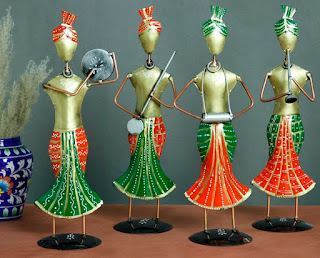Wrought iron figurines: The art in revival
Wrought iron, which is one of the two forms of iron obtained by smelting is superior to cast iron owing to lower carbon content in the former. Lower carbon content of wrought iron makes it harder and stronger yet easier to weld. The rulers in erstwhile Rajputana were patrons of metal arts iron figurines with a desire to decorate their interiors with iron artefacts.
 |
| Punjabi Musician Human Figurine |
How is a Human Figurine made?
Step 1: The iron rods are cut to size with the aid of power press machines and heated at high temperatures until malleable.
Step 2: According to the requirement, they are given the curvature & bent into the desired shape. This critical process is executed by skilled artisans of Northern India.
Step 3: Individual piece is then hammered and all components are welded together to roughly produce the shape of a figurine.
Step 4; The last step in this process is addition of zinc powder to provide the smooth finish and then the figurines are painted to perfection by local artisans.Decline in its popularity over time:
First, commercial steel, which is much cheaper than wrought iron and also has low carbon content has replaced the traditional metal for crafts purposes.Second, eventually due to growing demand of steel, the commercial production of wrought iron figurines declines in late 19th century.
The late rise
Lately, wrought iron figurines have managed to gain popularity due to the value driven market, high emphasis on handmade and environmentally sustainable crafts. Such crafts have developed their centers in Jodhpur (Rajasthan), parts of Jharkhand and Southern India.

Comments
Post a Comment